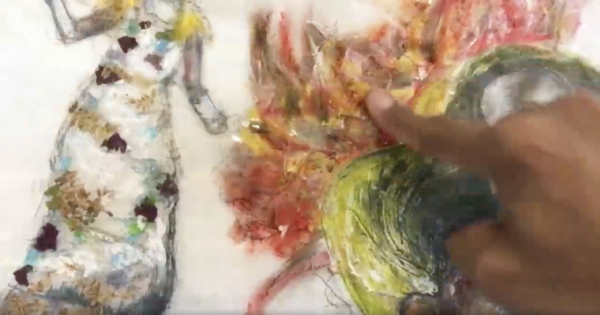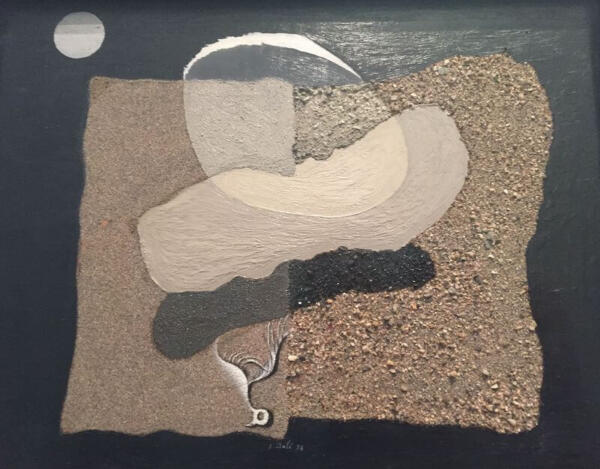Ronaldo Wilson’s Mole End exhibition—Carmelina: Sessions—closed yesterday with a spectacular evening of masked performances, improvised songs, Louis Vuitton, and a farewell lullaby.

I explore and enact narratives that interconnect, slip, and so I want some time with visitors. Carmelina: Sessions exists at the juncture of my poetry and interdisciplinary art practices, a project of African American and Asian American translation—in some quiet bass, from English to Tagalog, homemade movies, hi-sonic mixes, eavesdropping, journals hemorrhaging —forms explored in the emergence from experiencing the construction of the familial and figurative black and brown body, constructing it through a conceptual field of violation and spectacle through questions of migration, memory, form—
-Ronaldo Wilson, Carmelina: Sessions
Carmelina: Sessions includes a high-octane “oddcast” radio show (in which Wilson-as-DJ cycles through different callers/personas, languages, and registers) that loops throughout the gallery housing the artist’s latest exhibition of paintings, videos, and polaroids of his mother. Carmelina: Sessions not only responds to his mother’s “exile”—a result of her marrying Wilson’s father, a Black American soldier—but a number of Wilson’s props from past performances also spring up as assemblages of past and present (see Carmelina Figure below). The black mask from his short film Pink, the Lucy mask, the chicken mask, etc. Meanwhile, the “oddcast” performance, short films detailing the artist’s process, and the artworks themselves all seem to be working with and against one another in a show that confronts temporality and the distance between self and other.

from Persona, Meloody, Mask (2020) Video, 5:00.
Wilson continues to remind us: when creating art, there are excess layers of pain one must translate. “The song in the back of the art,” says Wilson during his closing performance. I think about this idea for the rest of the evening. The unseen room of art. The echo from the stage. The painting and, at the same time, the performance that results in the painting. Not to mention Wilson’s unorthodox painting materials: bird droppings (waste itself), tape, yellow synthetic feathers, sand, and more. Each ingredient adds/alters the initial graphite sketches (which Wilson is possibly linking to the Virgil from Virgil Kills: Stories from the Conservation of Mass).
Virgil rubs the graphite excess up with his forefinger, and uses it to shade in MommaSpine’s hair, or to begin to capture the fluid, contours of her body in motion, mid- Aerobics, in masks and full body costumes, in or out of Florin Convalescent.
Nearby monitors display videos of Wilson working on the paintings in their earliest stages. It’s fascinating to watch Wilson mold the reflective tape with his fingers, drag yellow pastel across the light being reflected, tape over the image. Lines of language also enter the canvas. Like in so many of Cy Twombly’s works, the writing/language becomes part of the painting.
The gallery continues to swell with the “oddcast”:
You know, most radio stations, they like to cut people off, but I like to give people a lot of time to move through the ideas. You know, because, this kind of radio show is for the masses. It’s all about the people. So let’s take the next call.

Carmelina Figure: Panel 2, 2018 Graphite, water soluble oil pastels, marker, glue, tape, leaves, grass, synthetic dyed feathers, sun dried seaweed, bird droppings, and beach sand on.
In some ways, the excessive layers and textures of Wilson’s paintings (like the one above) remind me of one of my favorite Dali paintings. For Wilson, an artist who deconstructs constructions of identity, even the idea of paint itself has no limits:

Dit gros, platja, lluna i ocell podrit (Thumb, Beach, Moon and Decaying Bird) (1928) Oil, sand and gravel on panel
I was especially fond of Wilson’s new short film, Lucy and Surely (2020). With a digitally altered voice, Wilson performs as a black bird in front of a tree of masks as white passersby gawk. “The song in the back of the art.” The internalized becomes externalized, made a “public” spectacle in the park. “the pitch of darkness that fills the room” Viewers begin to see how the outside is staged.

from Lucy and Surely (2020) Video, 7:17.
What is the difference between the outside and the inside of the dream that can only be explained in the pitch of darkness that fills the room in the vision of blue and black
Ronaldo Wilson’s Carmelina: Sessions exhibition can be viewed in its entirety online [here]
Paul Cunningham (b. 1989) is the author of the The House of the Tree of Sores (Schism2 Press, 2020) and The Inmost (Carrion Bloom Books, 2020), and the translator of Helena Österlund’s Words (OOMPH! Press, 2019). He has also translated two chapbooks by Sara Tuss Efrik: Automanias Selected Poems (Goodmorning Menagerie, 2016) and The Night’s Belly (Toad Press, 2016). His creative and critical work has most recently appeared in Snail Trail Press, Apartment Poetry, Kenyon Review, Quarterly West, Poem-a-Day, DIAGRAM, and others. He is a managing editor of Action Books, co-editor of Radioactive Cloud, and co-curator of the Yumfactory Reading Series. He is a PhD candidate at the University of Georgia. @p_cunning